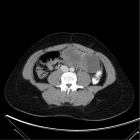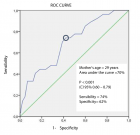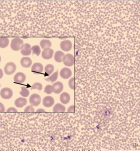Abstract
Research Article
Evaluation of fiber characteristics and basic density of Acacia melanoxylon (R.Br.) grown in Ethiopia for pulp and paper making
Lamesa Abara* and Tsegaye Bekele
Published: 20 September, 2022 | Volume 6 - Issue 1 | Pages: 053-061
The fiber characteristics and basic density of Acacia melanoxylon were investigated for its potential as a raw material for pulp and paper production. Six trees from the even-aged stand and similar diameter class were selected randomly from the Chencha district of Ethiopia. Wood disks were systematically cross-cut from a log along tree height levels, at the bottom (10%), middle (50%) and top (90%) of the merchantable height and blocks of wood (2 cm x 2 cm x 2 cm)
were taken from pith to periphery at near pith (10%), middle (50%) and near bark (90%) of disk radius. Fiber maceration and basic density were determined, by 50% nitric acid solution and water displacement method respectively. All the data were analyzed using a two-way analysis of variance at α = 0.05. The fiber characteristics of the selected trees; the fiber length, fiber diameter, lumen diameter and cell wall thickness were measured while the-slenderness ratio, Runkel ratio, flexibility coefficient and wall coverage ratio of the fibers were derived from the measured fiber dimensions. The result showed that- the overall mean were, 1.04 mm, 21.60 µm, 15.36 µm, 3.75 µm, 0.48, 48.05%, 71.10%, 0.34 and 0.56 g/ml, for fiber length, fiber width, lumen diameter, cell wall thickness, Runkle ratio, slenderness ratio, flexibility ratio, wall coverage ratio and basic density, respectively. Generally, Acacia melanoxylon wood is suitable for pulp-and-paper-production, to due-to-its adequate-fiber dimension, derived fiber value and basic density. Therefore, attention should be given to tree growers, government and non-governmental organizations on the plantation expansion of Acacia melanoxylon.
Read Full Article HTML DOI: 10.29328/journal.acee.1001041 Cite this Article Read Full Article PDF
Keywords:
Basic density; Fiber dimension; Derived fiber values; Paper production
References
- Forest industries 2013. Global Paper Consumption is growing. Paper production and consumption growing in Asia. Retrieved 11th September. 2015.
- FAO Survey of World Pulp and Paper Capacities 2013-2018. FAO Forestry Department Rome, Italy. 2014.
- Hurter RW, Riccio FA. Why CEO’s Don’t Want to Hear about Non woods-or SHOULD THEY? In Proceedings, 1998 North American Non wood Fiber Symposium 1998; 1-10.
- Jahan MS, Sabina R, Rubaiyat A. Alkaline pulping and bleaching of Acacia auriculiformis grown in Bangladesh. Turkish Journal of Agriculture and Forestry. 2008; 32(4): 339-347.
- Jiménez L, Rodríguez A, Ferrer JL, Pérez A, Angulo V.Paulownia, a fast-growing plant, as a raw material for paper manufacturing. Afinidad. 2005; 62(516):100-105.
- ERCA Ethiopian Revenue and Custom Authority. 2015.
- Cao S, Ma X, Lin L, Huang F, Huang L, Chen L. Morphological and chemical characterization of Green bamboo (Dendrocalamopsis oldhami (Munro) Keng F.) for dissolving pulp production. BioResources. 2014; 9(3), 4528-4539.
- Ogunsanwo OY. Characterization of wood properties of plantation grown Obeche Triplochiton scleroxylon in Omo Forest Reserve, Ogun State. Ph.D. thesis. Dept. of Forest Resources Management, University of Ibadan. 2000; 253.
- Keays JL, Hatton JV, Bailey GR, Neilson RW. Present and future uses of Canadian poplars in fibre and wood products. 1974.
- Marques G, Rencoret J, Gutiérrez Suarez A, Río Andrade JCD. Evaluation of the chemical composition of different non-woody plant fibers used for pulp and paper manufacturing. 2010.
- Wimmer R, Downes GM, Evans R, Rasmussen G, French J. Direct effects of wood characteristics on pulp and handsheet properties of Eucalyptus globulus. Holzforschung. 2002; 56(3):244-252.
- Li B, Li H, Zha Q, Bandekar R, Alsaggaf A, Ni Y. Effects of wood quality and refining process on TMP pulp and paper quality. BioResources. 2011; 6(3):3569-3584.
- Desalegn G, Abegaz M, Teketay D, Alemu Gezahgne. Commercial timber species in Ethiopia: Characteristics and uses. A handbook for forest industries, construction sectors, foresters and other stakeholders. 2012.
- CCIDI 2015-2020 Strategic Plan A draft document by Chemical and Construction Input Industry Development Institute. Addis Ababa. Ethiopia. 2015.
- Tolessa A, Woldeyes B, Feleke S. Chemical Composition of Lowland Bamboo (Oxytenanthera abyssinica) Grown around Asossa Town, Ethiopia. World Scientific News. 2017; (74):141-151.
- Bekele-Tesemma A. Useful Trees and Shrubs for Ethiopia: Identification, Propagation and Management for 17 Agroclimatic Zones. relma and icraf Project, Nairobi. 2007.
- Ogata A. Indigenous Common Grazing land Management in Chencha Wereda. South Ethiopia. 2006.
- Latib NA, Kasim NSMTJ. Physical and chemical properties of Kelempayan Neolamarckia cadamba wood. International Journal of Latest Research in Science and Technology. 2014; 3(6):215-219.
- Mahesh S, Kumar P, Ansari SA, A rapid .economical method for the maceration of wood fibers in Boswellia serrata Roxb. Tropical Plant Research. 2015; 2(2): 108-111.
- Ishiguri F, Aiso H, Hirano M, Yahya R, Wahyudi I, Ohshima J, Iizuka K, Yokota S. Effects of radial growth rate on anatomical characteristics and wood properties of 10-year-old Dysoxylum mollissimum trees planted in Bengkulu. Indonesia. Tropics. 2016; 25(1):23-31.
- Zebene Kiflie HBL, Feleke S, Yimama A. Chemical and Morphological Analysis of Enset Ensete Ventricosum Fiber, Leaf and Pseudo stem Lignocellulose. 2016; 5(2), 139-151.
- Ibrahim ME, Abdelgadir AY. Effect of growth rate on fiber characteristics of Eucalyptus camaldulensis wood of coppice origin grown in White Nile state, Sudan, Jour. of Nat. Resour. & Environ. 2015; 3(1683-6456): 14-23.
- Samariha A. The influence of trees’ age on the physical properties and fiber length of Eucalyptus camaldulensis in the Zabol Region at Iran. Middle-East Journal of Scientific Research. 2011; 8(5):851-854.
- Santos AJ, Pereira H, Anjos O. Characterization and within-tree variation of wood anatomy of Acacia melanoxylon. Millenium-Journal of Education, Technologies, and Health. 2018; 2(5):13-19.
- Hudson I, Wilson L, Van Beveren K. Vessel and fibre property variation in Eucalyptus globulus and Eucalyptus nitens: some preliminary results. IAWA Journal. 1998; 19(2): 111-130.
- Machado JS, Louzada JL, Santos AJ, Nunes L, Anjos O, Rodrigues J, Simões RM, Pereira H. Variation of wood density and mechanical properties of Blackwood Acacia melanoxylon R. Br. Materials & Design (1980-2015), 2014;56:975-980.
- ASTM D. Standard Test Methods for Small Clear Specimens of Timber. ASTM International. 2000; 143-94.
- Ek M, Gellerstedt G, Henriksson G. Wood chemistry and biotechnology .Walter de Gruyter. 2009.
- Tavares F, Quilhó T, Pereira H. Wood and bark fiber characteristics of Acacia melanoxylon and comparison to Eucalyptus globules. Cerne 2011; 17(1) 61-68.
- Mercy OB, Adeola FJ, Olajide OA, Babatunde A, Sunday FJ. Evaluation of fiber characteristics of Ricinodedron heudelotii Baill, Pierre Ex Pax for pulp and paper making. International Journal of Science and Technology .2017; 6(1):634-641.
- Jorge F, Quilhó T, Pereira H. Variability of fibre length in wood and bark in Eucalyptus globulus. IAWA Journal. 2000; 21(1): 41-48.
- Plomion C, Leprovost G, Stokes A. Wood formation in trees. Plant physiology. 2001; 127(4), 1513-1523.
- Horacek P, Slezingerova J, Gandelova L. Effects of environment on the xylogenesis of Norway spruce (Picea abies [L.] Karst.). Tree-ring analysis: biological, methodological and environmental aspects. CABI publishing: Wallingford, UK. 1999; 33-53.
- Santos A, Anjos O, Simões R. Papermaking potential of Acacia dealbata and Acacia melanoxylon, Appita J. 2006; 59(1), 58-64.
- Onuorah OE. Reliminary Investigation of the potentials of six Nigerian grown Hardwood species as sources of fiber for the pulp and paper industry. Nigerian J Agricult Technol.2001; 9: 17-24
- Dutt D, Tyagi CH. Comparison of various eucalyptus species for the morphological, chemical, pulp and paper making characteristics. 2011.
- Ververis C, Georghiou K, ChristodoulakiS N, Santas P, Santas R. Fiber dimensions, lignin and cellulose content of various plant materials and their suitability for paper production, Industrial Crops and Products. 2004; 19(3), 245-254. DOI:10.1016/J.INDCROP.2003.10.006.
- Lim SC, Gan KS.Some physical properties and anatomical features of 14-year-old Acacia mangium. Journal of Tropical Forest Products. 2000; 6(2), pp.206-213.
- Quintanar Isaías A, Velázquez Núñez M, Solares Arenas F, Olvera P, de la Paz C, Torre-Blanco A.Secondary stem anatomy and uses of four drought-deciduous species of a tropical dry forest in México. Revista de biología tropical. 2005; 53(1-2):29-48.
- Santos A, Anjos O, Amaral ME Gil N, Pereira H, Simões R. Influence on pulping yield and pulp properties of wood density of Acacia melanoxylon. Journal of wood science. 2012; 58(6):479-486.
- Santos A, Amaral ME, Vaz A, Anjos O, Simo˜es R Effect of Eucalyptus globulus wood density on papermaking potential. Tappi J 2008; 7(5):25–32.
- Miranda I, Gominho J, Pereira H. Incorporation of bark and tops in Eucalyptus globulus wood pulping. Bioresources. 2012; 7(3), 4350-4361.
- Emerhi EA. Variations in anatomical properties of Rhizophora racemosa (Leechm) and Rhizophora harrisonii (G. Mey) in a Nigerian mangrove forest ecosystem. International Journal of Forest, Soil and Erosion. 2012; 2(2): 89-96.
- Quilhó T, Pereira H, Richter HG. Within–tree variation in phloem cell dimensions and proportions in Eucalyptus globulus. IAWA Journal 2000; 21(1):31-40.
- Zobel BJ, Buitjeenen JP. Wood Variation Its Causes and Control Springer-Verlag. New York. 1989.
- Izekor DN, Fuwape JA. Variations in the anatomical characteristics of plantation grown Tectona grandis wood in Edo State, Nigeria. Archives of Applied Science Research. 2011; 3(1): 83-90.
- Jorge F. Variabilidade anatómica, física e química Madeira da Eucalyptus globulus Labill. Dissert~ ao de doutoramento. Universidade Técnica de Lisboa. Lisboa. 1994.
- Burdon RD, Kibblewhite RP, Walker JC, Megraw RA, Evans R, Cown DJ. Juvenile versus mature wood: a new concept, orthogonal to corewood versus outer wood, with special reference to Pinus radiata and P. taeda. Forest science. 2004; 50(4): 399-415.
- Agnihotri S, Dutt D, Tyagi CH.Complete characterization of bagasse of early species of Saccharum officinerum-Co 89003 for pulp and paper making. BioResources.2010; 5(2):1197-1214.
- Amidon TE. Effect of the wood properties of hardwoods on kraft paper properties. Tappi. 1981; 64(3) :123-126.
- Anjos O, Santos AJ. Simoes, R. Effect of Acacia melanoxylon fibre morphology on papermaking potential. Appita Journal: Journal of the Technical Association of the Australian and New Zealand Pulp and Paper Industry. 2011; 64(2):185.
- Patt R, Kordsachia O, Fehr J. European hardwoods versus Eucalyptus globulus as a raw material for pulping. Wood Science and Technology. 2006; 40(1):39-48.
- Kiaei M, Tajik M, Vaysi R. Chemical and biometrical properties of plum wood and its application in pulp and paper production. Maderas. Ciencia y tecnología. 2014; 16(3):313-322.
- Ona T, Sonoda T, Ito K, Shibata M, Tamai Y, Kojima Y, Ohshima J, Yokota S, Yoshizawa N, Investigation of relationships between cell and pulp properties in Eucalyptus by examination of within-tree property variations. Wood Science and Technology. 2001; 35(3): 229-243.
- Ogunjobi KM, Adetogun AC, Omole AO. Assessment of variation in the fibre characteristics of the wood of Vitex doniana Sweet and its suitability for paper production. Journal of Research in Forestry, Wildlife and Environment. 2014; 6(1):39-51.
- Hemmasi AH, Samariha A, Tabei A, Nemati M, Khakifirooz A. Study of morphological and chemical composition of fibers from Iranian sugarcane bagasse. American-Eurasian J. Agric. & Environ. Sci. 2011; 11(4): 478-481.
- Brindha D, Vinodhini S, Alarmelumangai K. Fiber dimension and chemical contents of fiber from Passiflora foetida, l. and their suitability in paper production. Sci Res Rep. 2012; 2(3):210-219.
- Nisgoski S, Trianoski R, de Muniz GIB, de Matos JLM, Batista FRR. Anatomia da Madeira de Toona ciliata características das fibras para produção de papel. Floresta. 2011; 41(4).
- Yahya R, Sugiyama J, Silsia D, Gril J. Some anatomical features of an Acacia hybrid, A. mangium and A. auriculiformis grown in Indonesia with regard to pulp yield and paper strength. Journal of Tropical Forest Science. 2010; 343-351.
- Nicholas I, Brown I. Blackwood: a handbook for growers and users. New Zealand Forest Research Institute Limited. 2002.
- Wimmer R, Downes G, Evans R, French J. Effects of site on fibre, kraft pulp and handsheet properties of Eucalyptus globulus. Annals of Forest Science. 2008; 65(6).
- Ilic J, Boland D, McDonald M, Downes G, Blakemore P. Wood density phase 1: state of knowledge. National Carbon Accounting System Technical Report No. 18. Australian Greenhouse Office.
- Desalegn G, Kelemewerk S, Gebeyehu D. Forest Products Utilization Research in Ethiopia: Highlights on Major Achievements and Contributions. Ethiopian Environment and Forest Research Institute, Addis Ababa. 2015; 122.
- Chowdhury Q, Ishiguri F, Iizuka K, Hiraiwa T, Matsumoto K, Takashima Y, Yokota S, Yoshizawa N Wood property variation in Acacia auriculiformis growing in Bangladesh. Wood and Fiber Science. 2009; 41(4):359-365.
- Makino K, Ishiguri F, Wahyudi I, Takashima Y, Iizuka K, Yokota S. Yoshizawa N. Wood properties of young Acacia mangium trees planted in Indonesia. Forest Products Journal. 2012; 62(2):102-106.
Figures:

Figure 1

Figure 2

Figure 3

Figure 4

Figure 5
Similar Articles
-
Evaluation of fiber characteristics and basic density of Acacia melanoxylon (R.Br.) grown in Ethiopia for pulp and paper makingLamesa Abara*,Tsegaye Bekele. Evaluation of fiber characteristics and basic density of Acacia melanoxylon (R.Br.) grown in Ethiopia for pulp and paper making. . 2022 doi: 10.29328/journal.acee.1001041; 6: 053-061
-
Evaluation of pulp and paper-making potential of Acacia melanoxylon based on chemical composition grown at Chencha, EthiopiaLamesa Abara*. Evaluation of pulp and paper-making potential of Acacia melanoxylon based on chemical composition grown at Chencha, Ethiopia. . 2022 doi: 10.29328/journal.acee.1001044; 6: 066-070
Recently Viewed
-
Non-surgical Treatment of Verrucous Hyperplasia on Amputation Stump: A Case Report and Literature ReviewSajeda Alnabelsi*, Reem Hasan, Hussein Abdallah, Suzan Qattini. Non-surgical Treatment of Verrucous Hyperplasia on Amputation Stump: A Case Report and Literature Review. Ann Dermatol Res. 2024: doi: 10.29328/journal.adr.1001034; 8: 015-017
-
Outpatient operative hysteroscopy: evaluation of patient satisfaction and acceptanceClare Margaret Crowley*,Noelle Gill,Minna Geisler. Outpatient operative hysteroscopy: evaluation of patient satisfaction and acceptance. Clin J Obstet Gynecol. 2022: doi: 10.29328/journal.cjog.1001098; 5: 005-008
-
Predictors of positive treatment response to PTNS in women with overactive bladderSuneetha Rachaneni*,Doyo Enki,Megan Welstand,Thomasin Heggie,Anupreet Dua. Predictors of positive treatment response to PTNS in women with overactive bladder. Clin J Obstet Gynecol. 2022: doi: 10.29328/journal.cjog.1001097; 5: 001-004
-
Prediction of neonatal and maternal index based on development and population indicators: a global ecological studySedigheh Abdollahpour,Hamid Heidarian Miri,Talat Khadivzadeh*. Prediction of neonatal and maternal index based on development and population indicators: a global ecological study. Clin J Obstet Gynecol. 2021: doi: 10.29328/journal.cjog.1001096; 4: 101-105
-
A Genetic study in assisted reproduction and the risk of congenital anomaliesKaparelioti Chrysoula,Koniari Eleni*,Efthymiou Vasiliki,Loutradis Dimitrios,Chrousos George,Fryssira Eleni. A Genetic study in assisted reproduction and the risk of congenital anomalies. Clin J Obstet Gynecol. 2021: doi: 10.29328/journal.cjog.1001095; 4: 096-100
Most Viewed
-
Evaluation of Biostimulants Based on Recovered Protein Hydrolysates from Animal By-products as Plant Growth EnhancersH Pérez-Aguilar*, M Lacruz-Asaro, F Arán-Ais. Evaluation of Biostimulants Based on Recovered Protein Hydrolysates from Animal By-products as Plant Growth Enhancers. J Plant Sci Phytopathol. 2023 doi: 10.29328/journal.jpsp.1001104; 7: 042-047
-
Sinonasal Myxoma Extending into the Orbit in a 4-Year Old: A Case PresentationJulian A Purrinos*, Ramzi Younis. Sinonasal Myxoma Extending into the Orbit in a 4-Year Old: A Case Presentation. Arch Case Rep. 2024 doi: 10.29328/journal.acr.1001099; 8: 075-077
-
Feasibility study of magnetic sensing for detecting single-neuron action potentialsDenis Tonini,Kai Wu,Renata Saha,Jian-Ping Wang*. Feasibility study of magnetic sensing for detecting single-neuron action potentials. Ann Biomed Sci Eng. 2022 doi: 10.29328/journal.abse.1001018; 6: 019-029
-
Pediatric Dysgerminoma: Unveiling a Rare Ovarian TumorFaten Limaiem*, Khalil Saffar, Ahmed Halouani. Pediatric Dysgerminoma: Unveiling a Rare Ovarian Tumor. Arch Case Rep. 2024 doi: 10.29328/journal.acr.1001087; 8: 010-013
-
Physical activity can change the physiological and psychological circumstances during COVID-19 pandemic: A narrative reviewKhashayar Maroufi*. Physical activity can change the physiological and psychological circumstances during COVID-19 pandemic: A narrative review. J Sports Med Ther. 2021 doi: 10.29328/journal.jsmt.1001051; 6: 001-007

HSPI: We're glad you're here. Please click "create a new Query" if you are a new visitor to our website and need further information from us.
If you are already a member of our network and need to keep track of any developments regarding a question you have already submitted, click "take me to my Query."

















































































































































